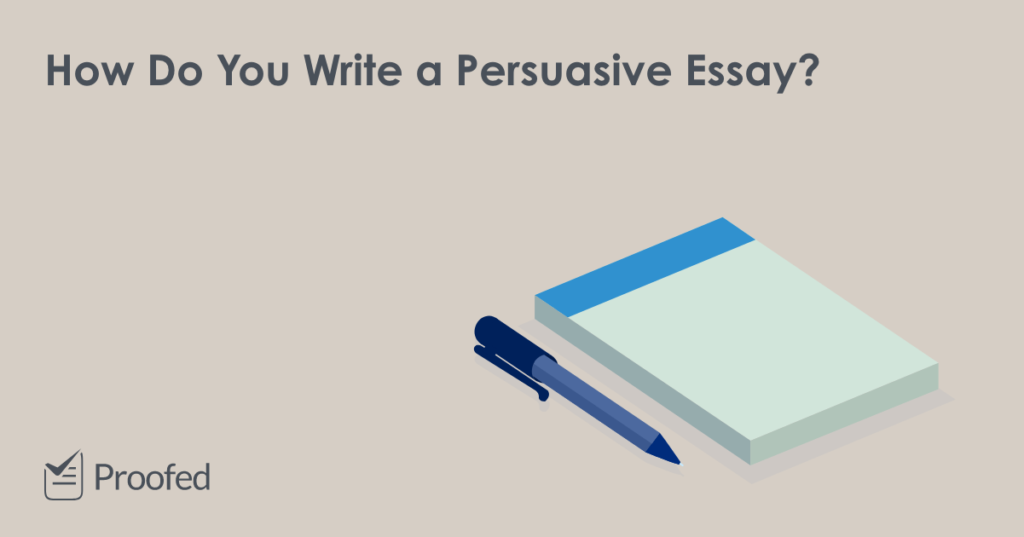A persuasive essay is one in which you take a stance on a topic and argue your position. But what goes into a good persuasive essay? In this post, we walk you through the basics of writing one, including:
- Selecting an essay topic and a position to argue.
- Researching information to support your arguments.
- Considering competing points of view.
- Planning and outlining your essay.
- Revising and proofreading your essay.
Read on below to find out more.
1. Selecting an Essay Topic and Position
A good persuasive essay topic will be something where you need to take a position and defend it, not a simple matter of fact.
For instance, you could write a persuasive essay about the social effects of economic inequality, arguing that it is either harmful or beneficial overall. But you wouldn’t write about the water cycle, because it’s a well-understood natural process with no room for debate.
When choosing an essay topic for a persuasive essay, then, make sure to:
- Check your essay prompt for guidance on what to write about.
- Select a subject where there is room for debate, not just a set of facts.
- Find something that you care enough about to argue for a position.
- Avoid topics that are too big to answer in a single essay (e.g., you might struggle to reach firm conclusions if you’re writing about the meaning of life, the universe, and everything).
You’ll then need to decide the position you’ll take on your topic. Typically, this means either arguing for or against a proposition: If you were writing about recycling, for instance, you could argue either that “Recycling is essential for the environment” or “Recycling is a waste of time and effort.” In the essay itself, you’ll then need to persuade the reader of the position you’ve chosen.
2. Research the Subject Area
Once you know what you’re writing about, it’s time to start your research! You may know something about the topic already, which is a great start, but you still need to back this up with evidence and arguments.
To do this, look at what other people have said on the topic. Focus on reliable sources – books, journal articles, and academic websites – and note down any facts, research, or expert opinions that either support or challenge the position you’ve decided to argue in your essay.
Find this useful?
Subscribe to our newsletter and get writing tips from our editors straight to your inbox.
3. Consider Different Points of View
As part of your research, don’t forget to consider different points of view. This means looking at arguments against your position as well as finding things that support it. There are two key reasons to do this:
- It will show you’ve reached a conclusion after looking at all the evidence rather than just picking a position and sticking to it regardless.
- Looking at potential objections to your argument means you can address them in your essay, strengthening your own position in the process.
You may even change your initial thoughts on the subject after researching it (e.g., if you were planning to argue that recycling is a waste of time, you might end up thinking it is more important than you realized). This is fine!
In fact, you can even use this to frame your essay: e.g., “When I began researching this topic, I thought [X]. Now, however, I believe [Y]. In this essay, I will explain why I changed my opinion and the arguments that led me to do so.”
4. Planning a Persuasive Essay
As with any essay, you need to plan what you’ll write before you start writing. And the best way to do this is to prepare an essay outline. For a persuasive essay, this usually includes four main sections:
- Introduction – A paragraph where you introduce the essay topic and your thesis statement (i.e., the position you will argue for in the essay).
- Main Body – A series of paragraphs in which you present each point of your argument and supporting evidence (e.g., research or expert opinions). Each paragraph should cover one main point, with the number of points required depending on the essay length.
- Conclusion – A final paragraph where you sum up how your arguments support your thesis. Try to end on a recommendation that follows from your position (e.g., “Based on these points, we need to recycle more”).
- References – If required, include a list of sources used in your research.
When you have worked out what you want to say, it’s time to start writing!
5. Revise and Proofread Your Essay
When you have a finished first draft, it’s time to redraft and polish. First, though, take a break. Ideally, you’ll leave it overnight and come back in the morning with fresh eyes. This will help you spot areas that you could improve, making the redrafting process much easier.
And when you’ve finished redrafting, don’t forget to have your essay proofread! This will ensure the final document is error free and easy to read, improving your chances of getting good marks.



